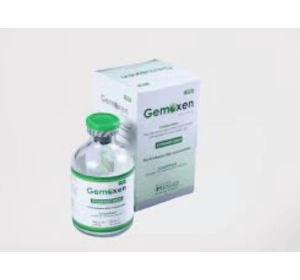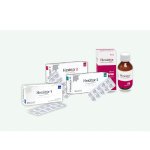Gemoxen

Generic Name:Gemcitabine
Indications
Non-Small Cell Lung Cancer: Gemoxen, in combination with Cisplatin, is indicated as a first-line treatment of patients with locally advanced (inoperable Stage lllA or IIIB) or metastatic (Stage IV) non-small cell lung cancer. Gemoxen is indicated for the palliative treatment of adult patients with locally advanced or metastatic non-small cell lung cancer.
Pancreatic Cancer: Gemoxen is indicated for the treatment of adult patients with locally advanced or metastatic adenocarcinoma of the pancreas. Gemoxen is indicated for patients with 5-FU refractory pancreatic cancer.
Bladder Cancer: Gemoxen is indicated for treatment of advanced bladder cancer (muscle invasive Stage IV tumors with or without metastases) in combination with Cisplatin therapy.
Breast Cancer: Gemoxen in combination with Paclitaxel, is indicated for the treatment of patients with metastatic breast cancer who have relapsed following adjuvant/neoadjuvant chemotherapy. Prior chemotherapy should have included an anthracycline, unless clinically contra-indicated.
Ovarian Cancer: Gemoxen in combination with Carboplatin, is indicated for the treatment of patients with recurrent epithelial ovarian carcinoma who have relapsed following platinum-based therapy.
Pharmacology
Gemcitabine (dFdC) is metabolised intracellularly by nucleoside kinases to the active diphosphate (dFdCDP) and triphosphate (dFdCTP) nucleosides. The cytotoxic action of Gemcitabine appears to be due to inhibition of DNA synthesis by two actions of dFdCDP and dFdCTP. First, dFdCDP inhibits ribonucleotide reductase which is uniquely responsible for catalysing the reactions that generate the deoxynucleoside triphosphates for DNA synthesis. Inhibition of this enzyme by dFdCDP causes a reduction in the concentrations of deoxynucleosides in general, and especially in that of dCTP. Secondly, dFdCTP competes with dCTP for incorporation into DNA. Likewise, a small amount of Gemcitabine may also be incorporated into RNA. Thus, the reduction in the intracellular concentration of dCTP potentiates the incorporation of dFdCTP into DNA (self-potentiation). DNA polymerase epsilon is essentially unable to remove Gemcitabine and repair the growing DNA strands. After Gemcitabine is incorporated into DNA, one additional nucleotide is added to the growing DNA strands. After this addition, there is essentially a complete inhibition in further DNA synthesis (masked chain termination). After incorporation into DNA, Gemcitabine then appears to induce the programmed cellular death process known as apoptosis.
Dosage & Administration
Non-Small Cell Lung Cancer:
- Single-agent Use: The recommended dose of Gemcitabine is 1000 mg/m2, given by 30-minute intravenous infusion. This should be repeated once weekly for three weeks, followed by a one-week rest period. This four-week cycle is then repeated. Dosage reduction with each cycle or within a cycle may be applied based upon the amount of toxicity experienced by the patient.
- Combination Use: Gemcitabine, in combination with Cisplatin has been investigated using two dosing regimens. One regimen used a three-week schedule and the over used a four-week schedule. The three-week schedule used Gemcitabine 1250 mg/m2, given by 30-minute intravenous infusion, on days 1 and 8 of each 21-day cycle. Dosage reduction with each cycle or within a cycle may be applied based upon the amount of toxicity experienced by the patient. The four-week schedule used Gemcitabine 1000 mg/m2, given by 30-minute intravenous infusion, on days 1,8, and 15 of each 28-day cycle. Dosage reduction with each cycle or within a cycle may be applied based upon the amount of toxicity experienced by the patient.
Pancreatic Cancer: The recommended dose of Gemcitabine is 1000 mg/m2, given by 30-minute intravenous infusion. This should be repeated once weekly for up to 7 weeks followed by a week of rest. Subsequent cycles should consist of injections once weekly for 3 consecutive weeks out of every 4 weeks. Dosage reduction with each cycle or within a cycle may be applied based upon the amount of toxicity experienced by the patient.
Bladder Cancer:
- Single agent use: The recommended dose of Gemcitabine is 1250 mg/m2, given by 30-minute intravenous infusion. The dose should be given on days 1,8 and 15 of each 28-day cycle. This 4-week cycle is then repeated. Dosage reduction with each cycle or within a cycle may be applied based upon the amount of toxicity experienced by the patient.
- Combination use: The recommended dose for Gemcitabine is 1000 mg/m2, given by 30-minute infusion, The dose should be given on days 1,8 and 15 of each 28-day cycle in combination with Cisplatin. Cisplatin is given at a recommended dose of 70 mg/m2 on day 1 following Gemcitabine or day 2 of each 28-day cycle. This 4-week cycle is then repeated. Dosage reduction with each cycle or within a cycle may be applied based upon the amount of toxicity experienced by the patient. A clinical trial showed more myelosuppression when Cisplatin was used in doses of 100 mg/m2.
Breast Cancer: Gemcitabine in combination with Paclitaxel is recommended using Paclitaxel (175 mg/m2) administered on Day 1 over approximately 3 hours as an intravenous infusion, followed by Gemcitabine (1250 mg/m2) as a 30-minute intravenous infusion on Days 1 and 8 of each 21-day cycle. Dose reduction with each cycle or within a cycle may be applied based upon the amount of toxicity experienced by the patient. Patients should have an absolute granulocyte count of at least 1,500 (x106/L) prior to initiation of Gemcitabine + Paclitaxel combination.
Ovarian Cancer: Gemcitabine in combination with Carboplatin is recommended using Gemcitabine 1000 mg/m2 administered on days 1 and 8 of each 21-day cycle as a 30-minute intravenous infusion. After Gemcitabine, Carboplatin should be given on day 1 consistent with target AUC of 4.0 mg/mL/min. Dosage reduction with each cycle or within a cycle may be applied based upon the amount of toxicity experienced by the patient.



